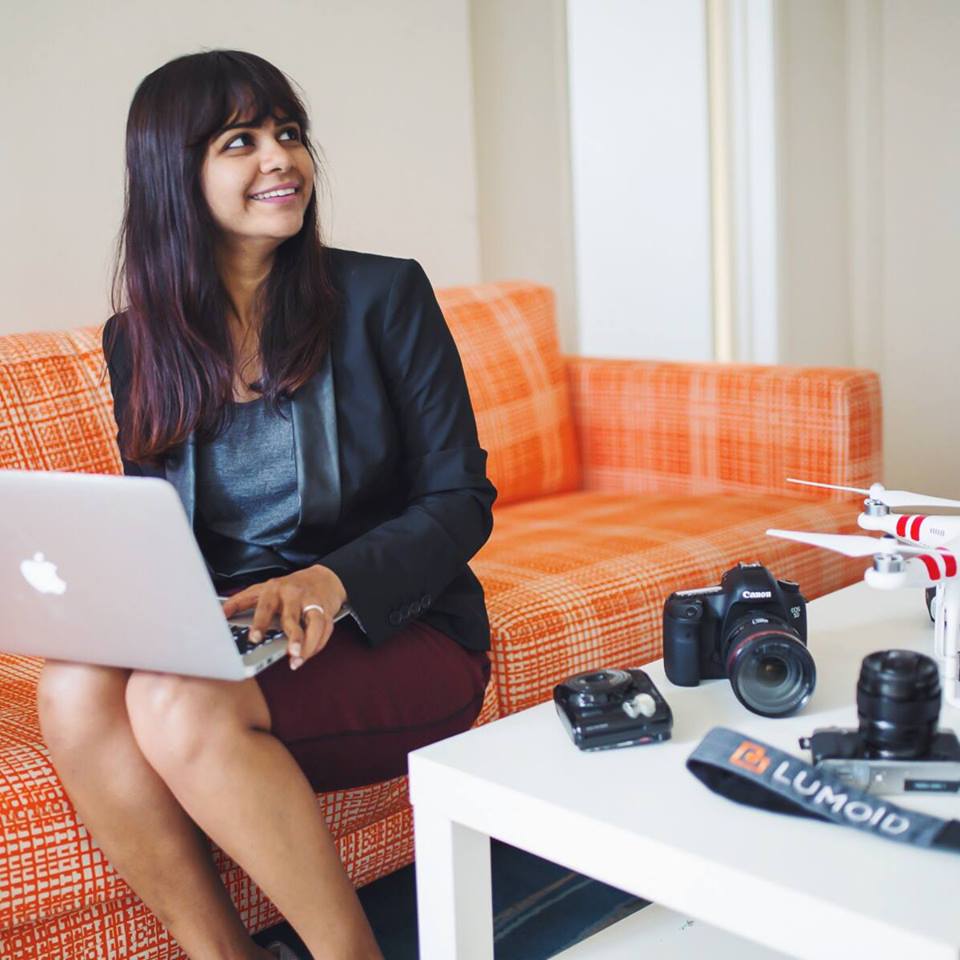Lumoid's Aarthi Ramamurthy on Tackling Founder Self-Doubt
by Y Combinator1/15/2016

The founder of gadget rent-to-buy platform Lumoid on the best solution for founder self-doubt, letting data surprise you, and seeing challenges as the new normal.
The Macro : From the start, Lumoid had a pretty unique business model. How did it all get started?
Aarthi Ramamurthy : It just started as a very basic idea — that people could rent consumer electronics, to test out different brands and models before they invested in buying. When we applied to Y Combinator it was just an idea. But I was so convinced it was going to work. I tested it out among friends and put up Facebook ads to point traffic to a basic landing page. I got 5,000 signups just like that. That’s how I first knew I was on to something.
We actually started out with the name of Striking. We didn’t have the URL of Striking.com — we only had GetStriking.com. It was really awkward to say over the phone. We always had to repeat ourselves. Every time we’d have a meeting with Paul Graham, he would be on our case: “Have you changed the name yet? You’ve got to change that name.” So we changed it to Lumoid. That was definitely the right choice.
The Macro : How did you build up your customer base?
Aarthi : Our first real customer who didn’t come from any of our personal networks came from Idaho. It was coming up on 4th of July weekend. At that time, all of the calls for the phone number on our website went to my cell phone. I was walking somewhere on the street and got a call — I was like, “Hello? Oh! Yes, yes, this is Striking, how can I help you?”
It was a guy who was about to leave on a roadtrip across the country. He wanted to try out this specific kind of camera on his trip before converting to buy it. He was really looking forward to it. And he needed it tomorrow.
I played it really cool on the phone, like, “Oh yeah, we’ve been doing this a long time. Give me an hour.” But inside I was panicking, because I knew that we didn’t have that specific camera in our inventory. Here was potentially our first real revenue from someone who wasn’t a friend of ours.
I started calling around to all the camera stores in the Bay Area and none of them had it in stock. I finally found a Best Buy in Colma that had one left. I said, “Please, please, hold it and reserve it for me. Please don’t let anyone else buy it.” I sped over there and bought the camera, put it in our packaging, and sped over to the FedEx store to get there in time to ship it off to him overnight.
So for four weeks, he’s traveling, he’s taking these beautiful photos, and he’s tagging us on Facebook the whole time. He actually ended up referring so many more customers to us just during that month. And he bought the camera at the end of the trip.
It was our first true customer success. That was just such a pivotal thing. We had so many things that were tough in those early days, and so many investors tell us, “You guys are smart, but the idea is so dumb. It’ll never work.” But we had that one customer who believed in it. He was like this beacon.
The Macro : How did you balance your belief in the business, when investors were telling you it wouldn’t work?
Aarthi : Well, to be honest, it wasn’t just investors doubting us. As a founder you go through a lot of self-doubt. Most founders don’t want to talk about it, because they feel like everyone would look down on them — if they’re not convinced, how can they convince anyone else? But in the early days there were times that I was dead sure that this is absolutely the right thing, and times where I thought this was the worst idea ever.
Jeff Bezos says to start with a customer and work backwards, and I think that’s really the only way to solve this problem. When you start with a customer and work backwards it reduces your self-doubt.
For us it was the customer in Idaho that let us know we were doing exactly the right thing. It wasn’t a friend of ours, it wasn’t pity revenue. It’s someone who absolutely did not know who we were, who was paying money to get this item. This was exactly how we had structured the business to work, and it was working. I thought, “I can scale this. I can do this. I can envision where this is going.”
The Macro : It sounds like in the beginning there was a ton of legwork on your part.
Aarthi : Oh yes. We did a lot of things that don’t scale. I mean, directing all the calls to my cell phone! Now we have a customer support team that has their own office. But in the early days, that’s the thing. It doesn’t matter what you’re doing, you pull over and you take that call.
I finally stopped directing calls to my cell phone when I had customers from the East Coast calling my phone at 5am every day. It’s nostalgic to think about those times now — but I’m also glad we’re through it.
The Macro : Any surprises along the way, things you wouldn’t expect?
Aarthi : We initially thought a lot of our customers would be these techie gadget nerds, coastal people, Facebook and Google employees. Then our first customer was from Idaho. Our biggest customers to this day are from the middle of the United States, from states like Kentucky, Idaho and Texas.
Then, when we expanded into wearables like Fitbit and Jawbone, we thought the market would be 75 percent male at least. And it was actually 60 percent female. When we started seeing those numbers, we thought, “That can’t be right, we need to recompute the data.” But it was right.
A lot of our assumptions probably stemmed from how these products have always been marketed. It turns out that we can teach these big companies things about their customer base that even they don’t know. Every vertical we’ve assumed something, and then the result is very different. You have to be receptive to what the data is telling you.
The Macro : What’s it like interacting with the consumer electronics industry as a startup?
Aarthi : We just did our first ever CES, and it was actually great. We got this confirmation that what we’re doing is more necessary than ever. We saw 50+ drone companies, 60+ fitness trackers. If you’re a consumer, you want to really make sure you’re going to like the one that you get. In the early days, even I’d say until maybe January of 2015, a lot of these companies wouldn’t want to talk to us because they couldn’t wrap their head around our model — is it retail, is it rental? But now they really get it. If you have a great product you have nothing to be afraid of.
We’re not a spendy splurgy company, so we had never been to CES before. This year we thought, OK, maybe it could be nice to show our faces to these brands we’ve been working with for so long. It ended up being very beneficial. Now I totally see the benefit of having events like this as part of our company’s strategy. I’m sure going to conferences is the norm for many companies, they know this already! But we’ve always done things a little differently — we never wanted to do something without really thinking about whether it’s the right thing or not. I think a lot of startups overhire, overspend, overdo things.
The Macro : Are there any personal habits that keep you grounded as Lumoid has grown?
Aarthi : Running is my meditation. Some days it’s the only way I can be by myself alone. I run at midnight, along the Embarcadero, about 3 days a week or so. That’s my thing. It’s the end of the day, so it helps me process everything. I’ll think, “There was that meeting, where I should have maybe said this,” or, “This is how i’m going to follow up on that one thing.” It’s nice to have the subconscious take over while you’re running. The things that were most important during the day just bubble up.
Then I get a second wind of energy and will stay up til 4am or so, doing a lot of the things I just thought about during the run. I guess I’m a workaholic, but it’s how I’m the happiest. I also have never needed a lot of sleep. If I fall asleep at 4am, I usually will wake up at 9am. I’ve always been like that.
The Macro : What advice would you give a first-time founder?
Aarthi : The one thing I’ve learned over the years is that as a founder, you’ll always have challenges. You’ll always have issues. It’s not just the early days. This is the norm. You need to have an adjustment in how you think about it. The challenges are there, and this is how life is going to be. The challenges change and you just keep getting tougher and stronger.
It’s not like you get over a hump and somehow it is easier. On YC Demo Day, we were like, “Wow, we made $10K in a month!” Nowadays we do that in the first couple of hours of the day. It’s still as hard now as it was then. You hit your first goals, then you think about how to reach the next ones. You get cash flow positive, and then you think about how to become the next Amazon.
The other thing I’m noticing is that my job varies all the time. I think I first heard this at a YC dinner, but I’ve seen how true it is: The job of a CEO is to pick up a task that nobody’s doing, and do it. You build yourself to a point that you’re really good at it, and then eventually you hire somebody and hand it off to them. So at any given point you’re never really good at anything, because once you are, you’re handing it off to someone else.
At the time I first heard about this I was skeptical, but it’s so true. I was doing Lumoid’s marketing for a long time, and now we’ve hired this person who’s doing it, and she is so much better than I’d ever been. Then I had to start from scratch on a different aspect of the business. We just hired our first full-time data scientist, and he’s the best at what he does. It’s a constant change of roles. You think of this stock photo image of what a CEO does as being something that’s set in stone, and it doesn’t exist.
Categories
Other Posts
Author

Y Combinator
Y Combinator created a new model for funding early stage startups. Twice a year we invest a small amount of money ($150k) in a large number of startups (recently 200). The startups move to Silicon